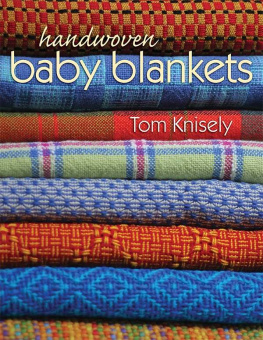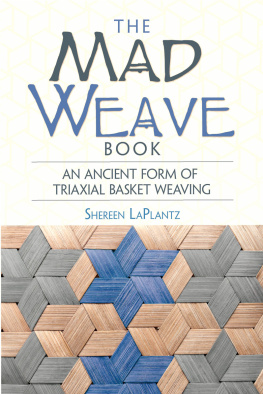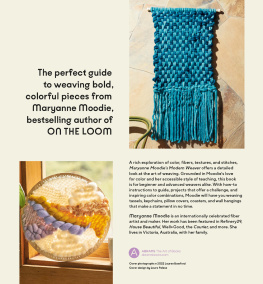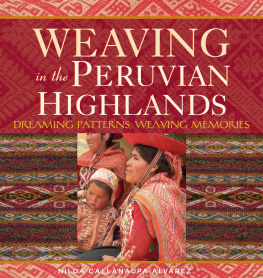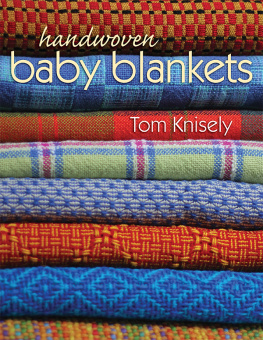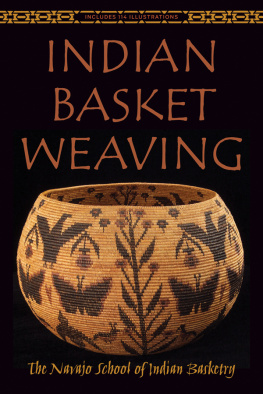
With Heartfelt Dedication
I would like to dedicate this book to all those weavers of rag rugs who left behind so many wonderful examples of their work for me to discover and to study.
Im sure they never considered their rag rugs to be works of art. Their resourcefulness, frugality, and creative ways are evident in each one of these old rag rugs. I am positive that their intent was to make a meager living at weaving or at least contribute to the familys income. I wonder if they thought about the little bits of torn fabric as they wove them into the rug. Did they think about these thin little contributions and remember where the fabric originally started out? Maybe they remembered that strip from the childrens play clothes and this piece from Grandmas old apronbut most likely they simply had a rug to weave, and dozens more after that. There was a job to do and they did it. I can promise you that they didnt think about me a hundred years in the future looking closely at their rugs and studying them and romantically making up stories in my mind about those little thin strips of fabric.
I am indebted to all these old weavers who have taught me through their work to have pride in what you weave and to make a quality product that will last for yearsjust as their rugs have. I hope that someday, someone will look at my work and wonder, if only for a moment, about the weaver who created the piece. I would like to think we all hope for this.
There is a wonderful saying that you sometimes find cross-stitched on old samplers and show towels that goes like this: When I am dead and in my grave and all my bones are rotten, when this you see, remember me, lest I be forgotten. A little morbid, dont you think? But just the same, a valuable quote to remember as you weave your own rag rug. Weave it with pride and weave it to last.
Happy weaving!
Contents
Introduction
I bought my first loom in 1976. It was a massive loom with two harness frames. Although my patterning possibilities were limited, it still allowed me to weave plain weave and I spent the next few months thinking about all the different ways that I could weave and make patterns with just two harness. Of course, 1976 was the bicentennial of our country and this united with my natural interest in history to raise my interest in anything remotely related to things Old Timey. Perhaps that is why I bought that huge antique barn frame loom rather than something of a more reasonable size for my home. In any event, it proved to be the right choice. When I discovered rag rugs, I had just the right loom to start weaving them on.
When you weave a rag rug, you join in a tradition that dates back over a hundred years. When exactly rag weaving began is unknown, but many believe it started in several places around the world, most likely during the late eighteenth or early nineteenth century. The practice began in part because of the industrial revolution and the introduction of machine-woven cotton fabric. Prior to this period, hand-woven fabric was a precious commodity, and people didnt have extra rags to tear up and weave into rugs. Even old, threadbare fabric would find a use somewhere else in the home: A large bed sheet with a hole would become a pillow case; worn-out pillow cases would be used as cleaning rags or to patch other fabrics. But with the invention of mechanical looms, fabric became much cheaper and quicker to make, and common people, for the first time, had fabric to spare for weaving into floor coverings.
Typical hit-and-miss rag rug from the early twentieth century
Fairly early on, merchants in the Americas were offering strips of brightly colored warp-face carpeting with bold stripes and some simple color and weave effects such as log cabin patterns. They were woven as plain weave on just two shafts and went by the name Venetian Carpets. (The carpeting was imported from England and had nothing to do with the city of Venice, Italy.) It didnt take long for American weavers to see the popularity of this type of carpeting, so they started weaving variations of this Venetian carpet. Weavers would take out advertisements in local newspapers offering their services to weave fancy coverlets or carpets.
In the later part of the nineteenth century, when the popularity of the coverlet started to decrease, weavers continued to weave rag carpets to keep their doors open. The weaver would provide the warp, and the customer would bring the weft for the rug, with the rags already cut into strips and sewn together. The weaver would have designed his or her own patterns for the rugs warp. These might be a simple plain colored cotton warp or an alternating light and dark colored warp. The later arrangement is known as log cabin and produces short horizontal dashes of dark and light colors.
When homeowners were ready to have new carpeting made, they would invite their community to come to their home for a carpet party. Rags and clothing that had been saved for years would be brought out and the guests attending the party would cut them into strips, sew the strips together, and wind them into balls. Those sewing the strips together were careful to mix up the colors of the fabric, avoiding having too many strips of the same color sewn together, which would result in large pools of a single color in the rug. This attractive style of alternating the colors randomly, mixing darks with lights, is now refered to as a hitand- miss rag rug.
Late-nineteenth-century Venetian carpet
Early-twentieth-century Japanese obis made using the sakiori technique
Rag rugs were also very popular throughout Scandinavia in the mid-nineteenth centuryand in such a cold climate its not hard to imagine why. I have seen photographs of nineteenth-century Scandinavian homes where rag rugs were laid close together and on top of each other to keep the drafts from coming up between the floorboards. A popular style of rag rugs from this period was ripsmatta; these rugs used bold geometric patterns with diamond and circle motifs, resembling coverlet patterns. These rugs were most likely woven by professional weavers, not by rural home weavers.
Around the same time in Japan, weavers were recycling cotton rags in a slightly different way. For many years, peasant farmers and coastal fisherman and their families wore clothing woven from bast fiber such as hemp, nettle, and the processed inner bark of trees. Around the mid- to late nineteenth century, rag merchants began to sell worn-out pieces of cotton fabric in the countryside. Rural weavers began to use strips of cotton fabric to inch wide as weft in hemp or other bast fiber warp. Using only two-shaft looms and weaving in plain weave, they produced a fabric that was not only much softer to the touch than the bast fabric they had been wearing, but also quite durable. This technique, known as sakiori, immediately became a popular way of weaving fabric for clothing. Sakiori was woven on narrow warps sometimes only twelve inches wide. In later years and even today, weavers have taken sakiori to a whole new level, weaving narrow strips of fabric that can only be described as works of art. Today,


